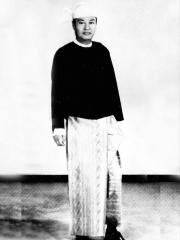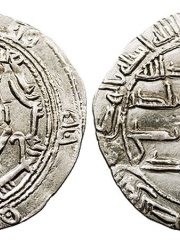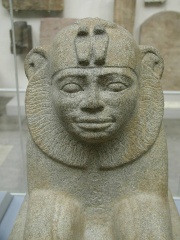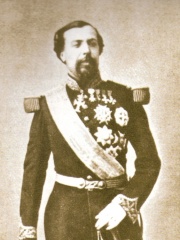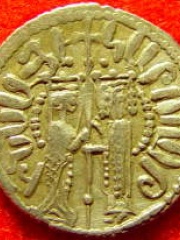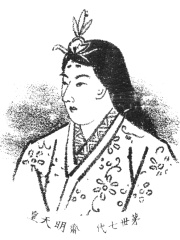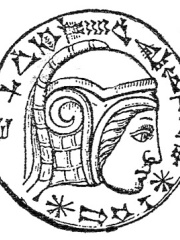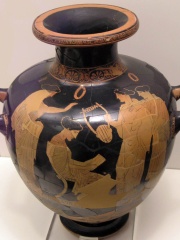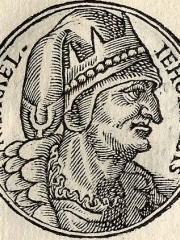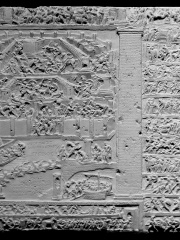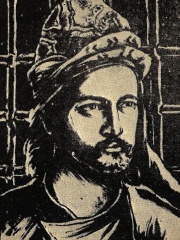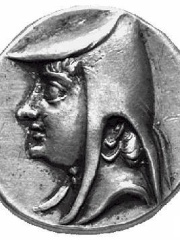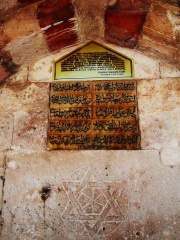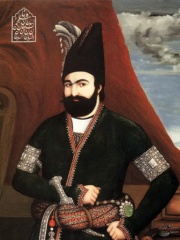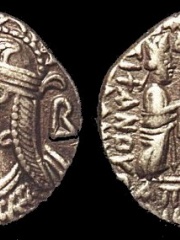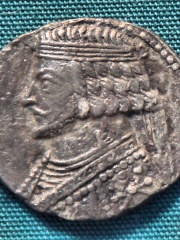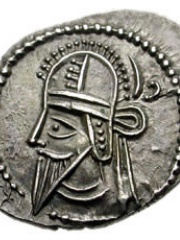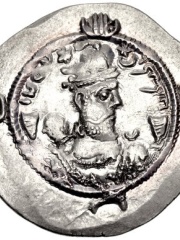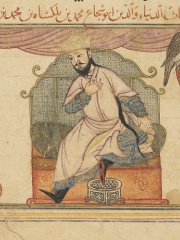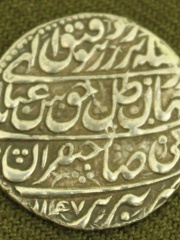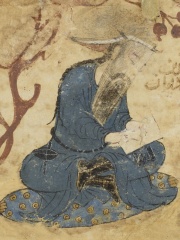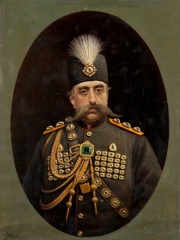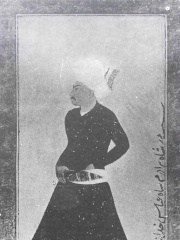POLITICIAN
Amytis of Media
630 BC - Today

 Amytis of Media
Amytis of Media
Amytis of Media (c. 630-565 BCE; Median: *ᴴumati; Ancient Greek: Ancient Greek: Αμυτις, romanized: Amutis; Latin: Amytis) was a queen of Babylon, wife of Nebuchadnezzar II and daughter of the Median king Cyaxares. Read more on Wikipedia
Her biography is available in 24 different languages on Wikipedia (up from 20 in 2024). Amytis of Media is the 3,829th most popular politician (up from 4,475th in 2024), the 130th most popular biography from Iran (up from 153rd in 2019) and the 76th most popular Iranian Politician.
Memorability Metrics
Page views of Amytis of Media by language
Among POLITICIANS
Among politicians, Amytis of Media ranks 3,829 out of 19,576. Before her are Gjon Kastrioti, Ne Win, Al-Hakam I, Prince George, Duke of Kent, Paul Bremer, and Taharqa. After her are Charles III, Prince of Monaco, Costas Simitis, Deiphobus, Isabella, Queen of Armenia, Empress Kōgyoku, and Daniel Cohn-Bendit.
Most Popular Politicians in Wikipedia
Go to all RankingsGjon Kastrioti
1400 - 1437
HPI: 68.25
Rank: 3,825
Ne Win
1910 - 2002
HPI: 68.25
Rank: 3,826
Al-Hakam I
770 - 822
HPI: 68.24
Rank: 3,827
Prince George, Duke of Kent
1902 - 1942
HPI: 68.24
Rank: 3,828
Paul Bremer
1941 - Present
HPI: 68.24
Rank: 3,829
Taharqa
800 BC - 664 BC
HPI: 68.24
Rank: 3,830
Amytis of Media
630 BC - Present
HPI: 68.24
Rank: 3,831
Charles III, Prince of Monaco
1818 - 1889
HPI: 68.23
Rank: 3,832
Costas Simitis
1936 - 2025
HPI: 68.23
Rank: 3,833
Deiphobus
HPI: 68.23
Rank: 3,834
Isabella, Queen of Armenia
1216 - 1252
HPI: 68.23
Rank: 3,835
Empress Kōgyoku
594 - 661
HPI: 68.23
Rank: 3,836
Daniel Cohn-Bendit
1945 - Present
HPI: 68.22
Rank: 3,837
Contemporaries
Among people born in 630 BC, Amytis of Media ranks 5. Before her are Nebuchadnezzar II, Sappho, Jehoahaz of Judah, and Stesichorus.
Others Born in 630 BC
Go to all RankingsNebuchadnezzar II
POLITICIAN
630 BC - 562 BC
HPI: 85.35
Rank: 1
Sappho
WRITER
630 BC - 570 BC
HPI: 83.03
Rank: 2
Jehoahaz of Judah
POLITICIAN
630 BC - 700 BC
HPI: 70.43
Rank: 3
Stesichorus
WRITER
630 BC - 555 BC
HPI: 69.23
Rank: 4
Amytis of Media
POLITICIAN
630 BC - Present
HPI: 68.24
Rank: 5
In Iran
Among people born in Iran, Amytis of Media ranks 130 out of 631. Before her are Jahan Shah (1397), Mohammad-Ali Rajai (1933), Shahab al-Din Yahya ibn Habash Suhrawardi (1155), Arsaces I of Parthia (-280), Haji Bektash Veli (1209), and Shahnaz Pahlavi (1940). After her are Mohammad Shah Qajar (1808), Vologases IV (150), Phraates IV (-90), Mulla Sadra (1571), Vologases VI (200), and Bahram Chobin (600).
Others born in Iran
Go to all RankingsJahan Shah
POLITICIAN
1397 - 1467
HPI: 68.51
Rank: 124
Mohammad-Ali Rajai
POLITICIAN
1933 - 1981
HPI: 68.50
Rank: 125
Shahab al-Din Yahya ibn Habash Suhrawardi
PHILOSOPHER
1155 - 1191
HPI: 68.46
Rank: 126
Arsaces I of Parthia
POLITICIAN
280 BC - 217 BC
HPI: 68.45
Rank: 127
Haji Bektash Veli
PHILOSOPHER
1209 - 1271
HPI: 68.44
Rank: 128
Shahnaz Pahlavi
COMPANION
1940 - Present
HPI: 68.29
Rank: 129
Amytis of Media
POLITICIAN
630 BC - Present
HPI: 68.24
Rank: 130
Mohammad Shah Qajar
POLITICIAN
1808 - 1848
HPI: 68.21
Rank: 131
Vologases IV
POLITICIAN
150 - 191
HPI: 68.17
Rank: 132
Phraates IV
POLITICIAN
90 BC - 2 BC
HPI: 68.06
Rank: 133
Mulla Sadra
PHILOSOPHER
1571 - 1636
HPI: 68.03
Rank: 134
Vologases VI
POLITICIAN
200 - 228
HPI: 67.99
Rank: 135
Bahram Chobin
MILITARY PERSONNEL
600 - 592
HPI: 67.87
Rank: 136
Among POLITICIANS In Iran
Among politicians born in Iran, Amytis of Media ranks 76. Before her are Muhammad I Tapar (1082), Abbas III (1732), Ata-Malik Juvayni (1226), Jahan Shah (1397), Mohammad-Ali Rajai (1933), and Arsaces I of Parthia (-280). After her are Mohammad Shah Qajar (1808), Vologases IV (150), Phraates IV (-90), Vologases VI (200), Mozaffar ad-Din Shah Qajar (1853), and Mohammad Khodabanda (1531).
Muhammad I Tapar
1082 - 1118
HPI: 68.66
Rank: 70
Abbas III
1732 - 1740
HPI: 68.64
Rank: 71
Ata-Malik Juvayni
1226 - 1283
HPI: 68.63
Rank: 72
Jahan Shah
1397 - 1467
HPI: 68.51
Rank: 73
Mohammad-Ali Rajai
1933 - 1981
HPI: 68.50
Rank: 74
Arsaces I of Parthia
280 BC - 217 BC
HPI: 68.45
Rank: 75
Amytis of Media
630 BC - Present
HPI: 68.24
Rank: 76
Mohammad Shah Qajar
1808 - 1848
HPI: 68.21
Rank: 77
Vologases IV
150 - 191
HPI: 68.17
Rank: 78
Phraates IV
90 BC - 2 BC
HPI: 68.06
Rank: 79
Vologases VI
200 - 228
HPI: 67.99
Rank: 80
Mozaffar ad-Din Shah Qajar
1853 - 1907
HPI: 67.81
Rank: 81
Mohammad Khodabanda
1531 - 1595
HPI: 67.77
Rank: 82

